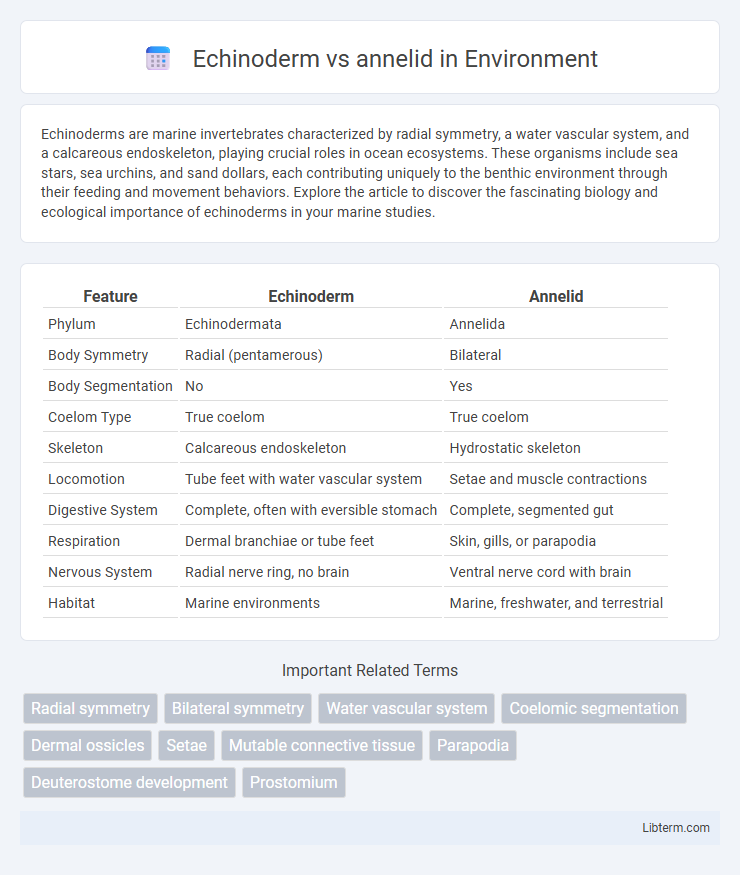Echinoderms are marine invertebrates characterized by radial symmetry, a water vascular system, and a calcareous endoskeleton, playing crucial roles in ocean ecosystems. These organisms include sea stars, sea urchins, and sand dollars, each contributing uniquely to the benthic environment through their feeding and movement behaviors. Explore the article to discover the fascinating biology and ecological importance of echinoderms in your marine studies.
Table of Comparison
| Feature | Echinoderm | Annelid |
|---|---|---|
| Phylum | Echinodermata | Annelida |
| Body Symmetry | Radial (pentamerous) | Bilateral |
| Body Segmentation | No | Yes |
| Coelom Type | True coelom | True coelom |
| Skeleton | Calcareous endoskeleton | Hydrostatic skeleton |
| Locomotion | Tube feet with water vascular system | Setae and muscle contractions |
| Digestive System | Complete, often with eversible stomach | Complete, segmented gut |
| Respiration | Dermal branchiae or tube feet | Skin, gills, or parapodia |
| Nervous System | Radial nerve ring, no brain | Ventral nerve cord with brain |
| Habitat | Marine environments | Marine, freshwater, and terrestrial |
Introduction to Echinoderms and Annelids
Echinoderms, characterized by their radial symmetry and a water vascular system, include sea stars, sea urchins, and sea cucumbers, inhabiting marine environments with a unique ability for regeneration and a calcareous endoskeleton. Annelids, such as earthworms, leeches, and polychaetes, display segmented bodies with a coelom and a closed circulatory system, thriving in diverse habitats from terrestrial to aquatic. Both phyla exhibit distinct evolutionary adaptations that underscore their ecological roles, with echinoderms playing crucial roles in marine ecosystems as benthic organisms, while annelids contribute significantly to soil health and nutrient cycling.
Key Differences in Body Structure
Echinoderms exhibit a unique radial symmetry with a calcareous endoskeleton and a water vascular system, whereas annelids display bilateral symmetry with segmented, soft bodies and a well-developed coelom. Echinoderms possess tube feet for locomotion and feeding, contrasting with the annelids' setae and parapodia used for movement. The echinoderm body plan is adapted for marine environments, while annelids include diverse terrestrial and aquatic species with complex organ systems.
Habitat and Distribution Comparison
Echinoderms primarily inhabit marine environments, ranging from shallow coastal waters to deep ocean floors, with species like sea stars and sea urchins prevalent in diverse oceanic regions worldwide. Annelids display broader habitat versatility, occupying marine, freshwater, and terrestrial ecosystems, with earthworms predominantly found in moist soil environments and polychaetes thriving in marine sediments. This distribution highlights echinoderms' exclusive marine adaptation versus annelids' ecological adaptability across multiple habitats.
Unique Locomotion Mechanisms
Echinoderms utilize a water vascular system with tube feet that operate through hydraulic pressure, enabling precise movement and adhesion to surfaces. Annelids rely on segmented body muscles and setae, tiny bristle-like structures, to crawl efficiently through soil or aquatic environments. The contrast between hydraulic locomotion in echinoderms and muscular peristalsis combined with bristle anchoring in annelids highlights their evolutionary adaptations to distinct habitats.
Reproductive Strategies
Echinoderms reproduce both sexually, with external fertilization in water, and asexually through regeneration, often producing larvae that undergo metamorphosis. Annelids primarily exhibit sexual reproduction with internal or external fertilization, some species being hermaphroditic, and many develop through direct or indirect development involving trochophore larvae. The reproductive strategies in echinoderms emphasize larval dispersal in open marine environments, whereas annelids show a broader range of reproductive modes adapted to diverse habitats.
Feeding and Digestive Systems
Echinoderms possess a water vascular system that aids in feeding, using tube feet to capture food and a stomach that can extend outside the body for digestion, which contrasts with annelids that have a complete digestive tract with a mouth, pharynx, esophagus, crop, gizzard, and intestine for efficient nutrient processing. Echinoderms primarily filter feed, scavenge, or prey on small organisms, relying on external digestion mechanisms, whereas annelids, such as earthworms and polychaetes, ingest soil or detritus, breaking down organic matter internally through a specialized gut. The structural differences in their digestive systems reflect adaptations to distinct ecological niches and feeding strategies in marine and terrestrial environments.
Nervous System and Sensory Adaptations
Echinoderms possess a decentralized nerve net and radial nerve ring functioning without a true brain, enabling coordination of tube feet and sensory cells detecting light and chemical changes. Annelids feature a more complex, segmented nervous system with a ventral nerve cord and paired ganglia, supporting advanced motor control and centralized processing. Sensory adaptations in echinoderms include eye spots and mechanoreceptors, while annelids have specialized structures like sensory bristles (setae) and statocysts for spatial orientation.
Ecological Roles and Importance
Echinoderms, such as starfish and sea urchins, play crucial roles in marine ecosystems by regulating prey populations and facilitating nutrient cycling through their feeding and burrowing activities. Annelids, including earthworms and polychaetes, are vital for soil aeration, organic matter decomposition, and enhancing nutrient availability, directly supporting terrestrial and aquatic ecosystem productivity. Both phyla contribute significantly to environmental stability and biodiversity, underscoring their ecological importance across different habitats.
Evolutionary Relationships
Echinoderms and annelids belong to distinct phyla within the animal kingdom, with echinoderms classified under Echinodermata and annelids under Annelida. Echinoderms exhibit radial symmetry and possess a unique water vascular system, traits that reflect their deuterostome lineage, closely related to chordates. In contrast, annelids display bilateral symmetry and segmented bodies characteristic of protostomes within the Lophotrochozoa clade, underscoring their divergent evolutionary pathways despite both being invertebrates.
Summary: Echinoderm vs Annelid
Echinoderms, such as starfish and sea urchins, exhibit radial symmetry, a water vascular system, and a calcareous endoskeleton, whereas annelids, including earthworms and leeches, display bilateral symmetry, segmented bodies, and a closed circulatory system. Echinoderms belong to the phylum Echinodermata and primarily inhabit marine environments, while annelids belong to the phylum Annelida and are found in diverse habitats including terrestrial, freshwater, and marine. The nervous system of echinoderms is decentralized with no brain, contrasting with the more complex, segmented nervous system of annelids.
Echinoderm Infographic

 libterm.com
libterm.com